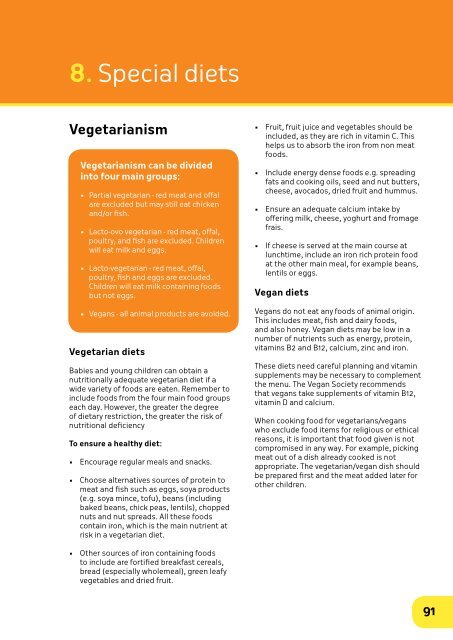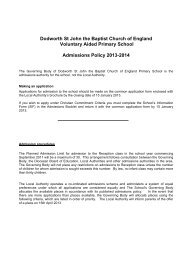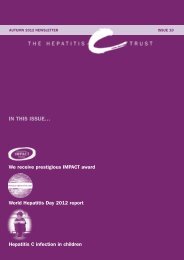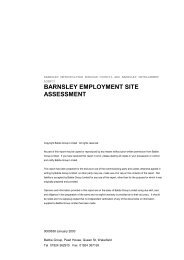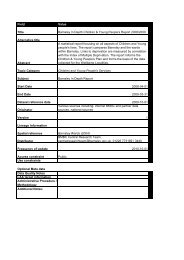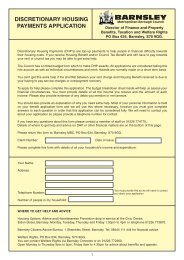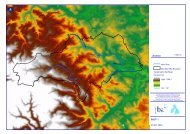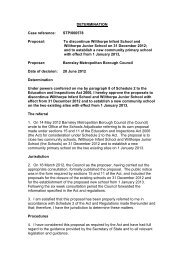Food and Nutrition Guidelines - Barnsley Council Online
Food and Nutrition Guidelines - Barnsley Council Online
Food and Nutrition Guidelines - Barnsley Council Online
Create successful ePaper yourself
Turn your PDF publications into a flip-book with our unique Google optimized e-Paper software.
8. Special diets<br />
Vegetarianism<br />
Vegetarianism can be divided<br />
into four main groups:<br />
• Partial vegetarian - red meat <strong>and</strong> offal<br />
are excluded but may still eat chicken<br />
<strong>and</strong>/or fish.<br />
• Lacto-ovo vegetarian - red meat, offal,<br />
poultry, <strong>and</strong> fish are excluded. Children<br />
will eat milk <strong>and</strong> eggs.<br />
• Lacto-vegetarian - red meat, offal,<br />
poultry, fish <strong>and</strong> eggs are excluded.<br />
Children will eat milk containing foods<br />
but not eggs.<br />
• Vegans - all animal products are avoided.<br />
Vegetarian diets<br />
Babies <strong>and</strong> young children can obtain a<br />
nutritionally adequate vegetarian diet if a<br />
wide variety of foods are eaten. Remember to<br />
include foods from the four main food groups<br />
each day. However, the greater the degree<br />
of dietary restriction, the greater the risk of<br />
nutritional deficiency<br />
To ensure a healthy diet:<br />
• Encourage regular meals <strong>and</strong> snacks.<br />
• Choose alternatives sources of protein to<br />
meat <strong>and</strong> fish such as eggs, soya products<br />
(e.g. soya mince, tofu), beans (including<br />
baked beans, chick peas, lentils), chopped<br />
nuts <strong>and</strong> nut spreads. All these foods<br />
contain iron, which is the main nutrient at<br />
risk in a vegetarian diet.<br />
• Fruit, fruit juice <strong>and</strong> vegetables should be<br />
included, as they are rich in vitamin C. This<br />
helps us to absorb the iron from non meat<br />
foods.<br />
• Include energy dense foods e.g. spreading<br />
fats <strong>and</strong> cooking oils, seed <strong>and</strong> nut butters,<br />
cheese, avocados, dried fruit <strong>and</strong> hummus.<br />
• Ensure an adequate calcium intake by<br />
offering milk, cheese, yoghurt <strong>and</strong> fromage<br />
frais.<br />
• If cheese is served at the main course at<br />
lunchtime, include an iron rich protein food<br />
at the other main meal, for example beans,<br />
lentils or eggs.<br />
Vegan diets<br />
Vegans do not eat any foods of animal origin.<br />
This includes meat, fish <strong>and</strong> dairy foods,<br />
<strong>and</strong> also honey. Vegan diets may be low in a<br />
number of nutrients such as energy, protein,<br />
vitamins B2 <strong>and</strong> B12, calcium, zinc <strong>and</strong> iron.<br />
These diets need careful planning <strong>and</strong> vitamin<br />
supplements may be necessary to complement<br />
the menu. The Vegan Society recommends<br />
that vegans take supplements of vitamin B12,<br />
vitamin D <strong>and</strong> calcium.<br />
When cooking food for vegetarians/vegans<br />
who exclude food items for religious or ethical<br />
reasons, it is important that food given is not<br />
compromised in any way. For example, picking<br />
meat out of a dish already cooked is not<br />
appropriate. The vegetarian/vegan dish should<br />
be prepared first <strong>and</strong> the meat added later for<br />
other children.<br />
• Other sources of iron containing foods<br />
to include are fortified breakfast cereals,<br />
bread (especially wholemeal), green leafy<br />
vegetables <strong>and</strong> dried fruit.<br />
91


